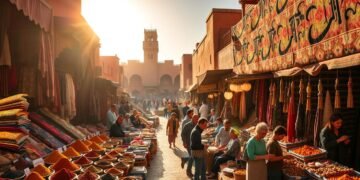Moroccan jewelry, recognized globally for its exquisite craftsmanship and intricate designs, is an embodiment of the country’s rich cultural past. The labyrinthic study of traditional Moroccan jewelry can be likened to an intriguing journey – one that offers keen insights into Morocco’s vibrant historical narrative.
From the enigmatic geometric patterns that are quintessential of Berber jewelry to the delicate filigree work that is characteristic of the craft originating from the Royal Cities, this article aims to unfurl the hidden beauty and profound symbolism of these bewitching pieces of jewelry. Herein, we delve into the different techniques, materials, and distinguishing characteristics that help define Moroccan jewelry as a standalone, authentic form of art.
An In-depth Exploration of Regional Moroccan Jewelry
Morocco takes great pride in its deep-rooted tradition of artisanal jewelry, particularly evident within its Jewish community. Two primary styles stand out – Berber and Tuareg. Berber jewelry displays a bold prowess for design, with elaborate necklaces, intricate headbands, and extravagant bracelets, all adorned with semi-precious stones and unique talismans. Conversely, Tuareg jewelry predominately utilizes silver and bronze, often etched with delicate geometric or floral motifs.
Emblematic items like the mdama belt and the khalkhal ankle bracelets are commonplace, drawing attention with their remarkable craftsmanship.
Additionally, the khamsa popularly referred to as the Hand of Fatima, a recognized symbol of protection, is frequently featured in these designs. Genuine antique Moroccan jewelry, due to its high value, is often hard to come by. However, a trip to cities such as Marrakech, Fez, and Tangier can result in potential finds. It is pertinent to differentiate authentic pieces from replicas by considering crucial factors such as weight, craftsmanship, and the quality of the stones. A well-practiced intuition can also be an invaluable tool in this endeavor.
Examining the Distinct Jewelry Types of Morocco
Mdama: The Epitome of Moroccan Classic Jewelry
A standout piece in Moroccan jewelry is the Mdama – a traditional belt typically adorned and complemented with caftans or takchitas. For those keen on acquiring authentic Moroccan jewelry, touring cities like Marrakech, Fez, Tangier, and Chefchaouen is highly recommended.
Additionally, Taroudant, a city known for its traditional jewelry market, is definitely worth a visit. However, the task of discerning genuine pieces from replicas involves a keen eye for detail especially in terms of weight, craftsmanship, and the quality of the stones. Trusting your judgment is absolutely vital when making such an investment.
Khalkhal: The Embodiment of Ankle Beauty
The Khalkhal is a visually stunning ankle bracelet that is a signature staple of Moroccan jewelry. Made from precious metals and adorned with attractive talismans, the Khalkhal is a testament to Morocco’s rich cultural traditions. Symbolizing security and positivity, it’s a favorite among locals and visitors alike. When purchasing jewelry in Morocco, it is important to scrutinize details like weight, craftsmanship, and the quality of the gemstones.
Traditional markets in cities like Marrakech, Fez, and Tangier boast a variety of genuine jewelry options.
The Timeless Silver Bracelets of Morocco: A Nod to Traditions
Moroccan jewelry vividly highlights the timeless allure of silver bracelets. These accessories, often decorated with the Khamsa or Hand of Fatima, are believed to offer protection. Authentic antique pieces may be difficult to procure as most of these are inherited and treasured in families for generations. For enthusiasts interested in purchasing these authentic pieces, it is best to explore cities noted for their jewelry markets like Marrakech, Fez, Tangier, and Chefchaouen.
In addition, the city of Tiznit, famous for its annual jewelry event, is also a location worth exploring. Inspecting details like weight, craftsmanship, and the quality of the gemstones can be a guide to establish the piece’s authenticity.
Khamsa: The Significance of the Hand of Fatima
A recurring motif in traditional Moroccan jewelry is the Khamsa, also known as the Hand of Fatima. As a symbol that wards off negative vibes, the Khamsa is frequently incorporated in numerous jewelry items, from necklaces to charms. The emblematic cultural and spiritual importance of the Khamsa is accentuated in Moroccan jewelry.
When investing in authentic pieces, it is advised to visit established markets and scrutinize aspects like weight, craftsmanship, and the quality of the stone for genuine assurance.
Navigating Through the Treasury of Antique Moroccan Jewelry
For antiquarians and connoisseurs of history, Moroccan jewelry offers styles that are steeped in sheer traditional artistry and craftsmanship. Berber jewelry stands out with its bold, heavy adornments and talisman-bearing designs, while Tuareg jewelry is distinguished by its unique use of silver and bronze, intricately engraved with either geometric or floral patterns. These accessories represent Morocco’s tangible heritage, with their distinct designs reflecting a clear southern influence.
However, acquiring these antique pieces can be quite a challenge due to their rarity and high value. The key to a successful and authentic shopping experience lies in exploring cities renowned for their markets, for example, Marrakech, Fez, Tangier, and Chefchaouen, and in visiting Taroudant’s celebrated jewelry market. A trip to Tiznit, well-known as a central marketplace for its variety in styles and prices, is also worth considering.
Checking aspects like the weight, intricacy of the craftsmanship, and quality of the gemstones is the surest way to ensure a wise acquisition.
An All-Encompassing Guide to Buying Moroccan Jewelry Both In-Situ and Online
Mastering the Art of Spotting the Real from the Fake in Moroccan Markets
Spotting the difference between genuine and counterfeit Moroccan jewelry requires a discerning eye and understanding of the craft. A pro-tip for potential buyers is to explore cities like Marrakech, Fez, Tangier, and Chefchaouen, all of which are famed for their genuine markets offering authentic jewelry. Tiznit, in particular, hosts a weekly Souk and an annual jewelry event, establishing itself as a mainstream marketplace for genuine pieces.
Buyers are advised to compare aspects like weight, craftsmanship, and the quality of the gemstones. Visiting Ensemble Artisanal in Tiznit or Marrakech can provide valuable insights into the various styles and price brackets.
The Enigmatic Symbolism Embedded in Emblematic Moroccan Jewelry Designs
Berber Necklaces: An Ode to Enduring Moroccan Traditions
Berber jewelry is revered for its opulent pieces that are generously decorated. Possessing an array of chunky necklaces, headbands, and bracelets, all bedecked with semi-precious stones and talismans, these pieces are mainstream in Berber culture. The Hand of Fatima, a protective symbol, is often featured, reflecting the indigenous culture of the region.
Diesel items such as the mdama belt and khalkhal ankle bracelet are also worthy of attention due to their intricate designs and cultural rich history. Both authentic and replica versions of Moroccan silver bracelets are a coveted accessory. The ever-present khamsa symbol, the protective Hand of Fatima, reflects the spiritual infusion that is characteristic of Moroccan jewelry.
Exploring the Rich Essence of Moroccan Hamsa Jewelry
Moroccan Hamsa Jewelry, rich in symbolism, features the Hand of Fatima – an enchanting talisman believed to ward off negativity. Born out of cultural richness, these distinct jewelry pieces typically incorporate silver and bronze in intricate geometric or floral detailing. The Khamsa or Hand of Fatima often makes an appearance in various jewelry items such as necklaces, bracelets, and anklets.
With vintage pieces typically inherited and passed down through generations, finding an antique piece may prove challenging. Enthusiasts looking to purchase these culturally rich artifacts should consider exploring major cities and reputable markets known for their authentic offerings.
Additionally, features like weight, level of craftsmanship, and the quality of stones can aid in establishing authenticity.
Breaking Down the Pricing Scheme of Decoding the True Worth of Moroccan Jewelry
Moroccan Jewelry spans an impressive spectrum from the widely adorned Berber designs to the geometrically rich designs in Tuareg jewelry. Investing in these artistic pieces often requires a tour of cities such as Marrakech, Fez, Tangier, Chefchaouen, and Taroudant to discover the best and the most authentic pieces. However, the daunting task lies in distinguishing between authentic offerings and imitation replicas.
Observing features such as the weight, the excellence in craftsmanship, and the quality of the stones can shed light on the piece’s authenticity.


























